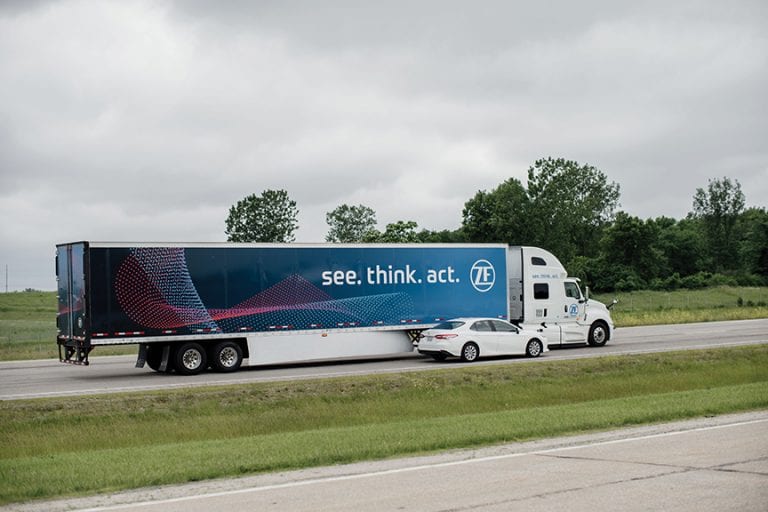Oh, how technology can change the playing field. Smartphones are a prime example.
As smartphones have become a constant companion for most people in the U.S., landline phones are rapidly losing their relevance. In 2004, more than 90% of U.S. adults lived in households that had an operational landline phone.
Now it is less than 40%, according to data provided by the Centers of Disease Control and Prevention, which has been tracking phone ownership in the U.S. as a byproduct of its biannual National Health Interview Survey since 2004.
If the trend toward mobile phones continues, and there’s little reason to believe it won’t, landline phones could soon become an endangered species, much like the VCR and other technological relics before it.
Technology has also had an impact on commercial motor vehicle (CMV) safety equipment. In the future, there will be fewer and fewer trucks on the road without safety systems.
“Heavy commercial vehicle technology for safety has developed in capability and application and is having a positive impact on truck safety,” said CAVita Founder Peter Sweatman.
He founded the company on the premise that now, more than ever, public and private companies, municipalities, and organizations need expertise to successfully navigate and take advantage of the opportunities presented by transportation’s evolution. “And the potential for further safety improvements is exciting,” he added.
Because of the size and diversity of the commercial vehicle market, data shows the percentage of tractor-trailers equipped with some type of advanced safety system is quite high. A vast majority of carriers have been adding safety technology to their trucks in the years since 2005 when Bendix Commercial Vehicle Systems introduced Bendix ESP (electronic stability program), the Bendix-branded ESC system.
In fact, in mid-2015 the National Highway Traffic Safety Administration (NHTSA) issued a rule that mandated electronic stability control on all Class 7 and Class 8 trucks starting in 2017.
Perhaps the NHTSA mandate and growing acceptance among carriers to heavily equip their fleets with safety features will soon make trucks with no safety features obsolete.
What overarching general technologies made it possible to begin to develop the safety technologies?
Two things, according to ZF North American Commercial Vehicle Marketing and Business Development Leader Collin Shaw. ZF just recently completed the acquisition of commercial vehicle technology supplier WABCO.
“First is the availability of low-cost radars and cameras that are more reliable and can stand up to the rigors of automotive,” said Shaw. “The second which isn’t as intuitive, are the algorithms that have been continually developed and refined to help radars and cameras distinguish objects and vehicles. Engineers have continuously worked to refine the algorithms that allow sensors and braking and steering technology to work together for a more refined experience for drivers.”
“I always go back to sensors,” stated Bendix Director of Marketing and Customer Solutions, Controls TJ Thomas, when asked about technological advances. “If you can sense more items or more things around your vehicle or on your vehicle, then you have an opportunity to do something with that information.”
While CMV safety systems have been around now for over 15 years, the past 24 months have been particularly good at ZF, said Shaw.
“By acquiring a specialist and market leader for commercial vehicle braking systems, we could add a stable and growing business segment and enable our existing commercial vehicle division to expand its expertise in vehicle dynamics control. It also allows ZF to capitalize on the opportunity to integrate braking, steering and Advanced Driver Assistance Systems (ADAS) like never before and fully unlock the power of what ADAS can do, including enabling new capabilities like pedestrian advanced emergency braking and adaptive cruise stop-and-go,” added Shaw.
Thomas pointed out that one of the advances at Bendix involves the Bendix Wingman Fusion system, first released in 2015.
“We’ve added new features and capability of using the existing platform,” said Thomas. “For example, when we launched it, we did not have features like highway departure, warning and braking, or multilane AED. Those are new features that we use with the original radar and camera. We can also improve the collision mitigation performance. Going forward, you are going to see more platform changes.”
Shaw said one of the upcoming features will make steering easier.
“The core of our ADAS features for commercial trucks is ReAX. This electronic control system is designed to work together with a hydraulic system to provide drivers with steering that helps to make the truck easier to drive while reducing fatigue,” noted Shaw. “While traveling at highway speeds, ReAX can provide a steering feel that is more rigid and stable. And at low speeds, the adaptive system is able to help reduce steering efforts required of the driver, designed to make maneuvering in a freight yard or backing up to a trailer or dock much less fatiguing. In essence, ReAX brings much of the feel and ease of operating a passenger car over to heavy trucks.”
Lyndon Finney’s publishing career spans over 55 years beginning with a reporter position with the Southwest Times Record in Fort Smith, Arkansas, in 1965. Since then he’s been a newspaper editor at the Southwest Times Record, served five years as assistant managing editor of the Arkansas Democrat-Gazette in Little Rock and from November 2004 through December 2019 served as editor of The Trucker. Between newspaper jobs he spent 14 years as director of communications at Baptist Health, Arkansas’ largest healthcare system. In addition to his publishing career he served for 46 years as organist at Little Rock’s largest Baptist church.















